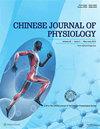Connexin 43通过血管内皮生长因子和血管生成素-1介导补阳还五汤缺血性脑卒中后血管生成
IF 1.6
4区 医学
Q4 PHYSIOLOGY
引用次数: 3
摘要
补阳还五汤是治疗缺血性脑卒中的经典方剂,具有促进局灶性缺血后血管生成的作用。然而,BYHWD对血管生成的作用机制尚不清楚。连接蛋白43 (Connexin 43, Cx43)在神经胶质血管单位的功能中起重要作用。因此,本研究的目的是探讨Cx43在BYHWD治疗后缺血性脑血管生成中的潜在作用。采用大脑中动脉闭塞法(MCAO)建立局灶性缺血模型。BYHWD在MCAO后每天灌胃两次,加或不加Gap26(一种特异性Cx43抑制剂)。Western blot、神经缺损、免疫荧光染色和Evans蓝染色证实Cx43在BYHWD治疗后血管生成中的作用。BYHWD可上调总Cx43和磷酸化Cx43的表达水平,并在MCAO后7天达到峰值。Gap26抑制Cx43显著减弱了BYHWD在神经行为中的保护作用。BYHWD治疗通过微血管密度增加、血管内皮生长因子(VEGF)和血管生成素-1 (Ang-1)上调来促进血管生成,而Gap26抑制Cx43则减弱了BYHWD的这些作用。此外,Gap26抑制了BYHWD对血脑屏障(BBB)完整性的有益作用。这些结果表明,Cx43通过VEGF和Ang-1介导局灶性缺血性脑卒中后BYHWD的血管生成。本文章由计算机程序翻译,如有差异,请以英文原文为准。
Connexin 43 mediated the angiogenesis of buyang huanwu decoction via vascular endothelial growth factor and angiopoietin-1 after ischemic stroke
Buyang Huanwu decoction (BYHWD), a classical prescription for ischemic stroke, has been reported to promote angiogenesis after focal ischemia. However, the mechanisms of the contribution of BYHWD on angiogenesis are still unclear. Connexin 43 (Cx43) played important roles in the functions of neurogliovascular unit. Therefore, the aim of this study was to explore the potential role of Cx43 in angiogenesis of the ischemic brain after BYHWD treatment. Middle cerebral artery occlusion (MCAO) was used to establish the model of focal ischemia. BYHWD was administrated intragastrically twice a day after MCAO with or without Gap26 (a specific Cx43 inhibitor). Western blot, neurological deficits, immunofluorescent staining, and Evans blue dye were used to confirm the role of Cx43 in angiogenesis after BYHWD treatment. The expression levels of total Cx43 and phosphorylated Cx43 were upregulated by BYHWD and peaked at 7 days post MCAO. Inhibition of Cx43 with Gap26 significantly attenuated the protective role of BYHWD in neurological behavior. BYHWD treatment promoted angiogenesis demonstrated by increased microvascular density, upregulated vascular endothelial growth factor (VEGF), and angiopoietin-1 (Ang-1), while inhibition of Cx43 with Gap26 attenuated these effects of BYHWD. In addition, Gap26 inhibited the beneficial effect of BYHWD on blood-brain barrier (BBB) integrity. These results suggested that Cx43 mediated the angiogenesis of BYHWD via VEGF and Ang-1 after focal ischemic stroke.
求助全文
通过发布文献求助,成功后即可免费获取论文全文。
去求助
来源期刊
CiteScore
2.30
自引率
5.60%
发文量
36
审稿时长
6-12 weeks
期刊介绍:
Chinese Journal of Physiology is a multidisciplinary open access journal.
Chinese Journal of Physiology (CJP) publishes high quality original research papers in physiology and pathophysiology by authors all over the world. CJP welcomes submitted research papers in all aspects of physiology science in the molecular, cellular, tissue and systemic levels. Multidisciplinary sciences with a focus to understand the role of physiology in health and disease are also encouraged.
Chinese Journal of Physiology accepts fourfold article types: Original Article, Review Article (Mini-Review included), Short Communication, and Editorial. There is no cost for readers to access the full-text contents of publications.

 求助内容:
求助内容: 应助结果提醒方式:
应助结果提醒方式:


